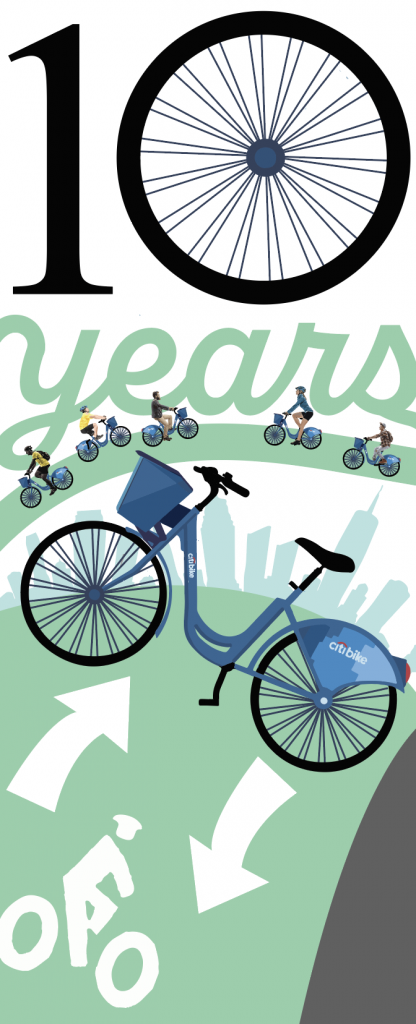Ten years of Citibike

The summer of 2014. I was seventeen, and visiting
my brother for the first time in his unfamiliar new
life at the bottom tip of Manhattan. He had just
turned 23 and, like me, hadn’t spent much time in
New York until now. Determined to orient himself in
the city before starting his new job, he wanted to cover as much ground as possible that weekend. Earlier that summer, his brand-new foldable Brompton bicycle – a graduation gift from my mother – had been lock-smashed and swiped from his front porch in Boston.
That weekend visit was the first time I remember using a Citi Bike. I inserted my People’s Bank debit card in the large blocky kiosk and quietly swallowed a lump in my throat after agreeing to the $200 dollar hold on my card in case of loss or damages. Still, I felt honored to be exploring my brother’s new home and tried my best to keep up. And for a while, I did. But I have vague recollections of struggling behind him, seeing him get smaller and smaller beneath the landscape of the Manhattan Bridge. Winded and slow.
This upcoming May, depending on how you feel, you’ll either be celebrating or denouncing the 10 year anniversary of Citi Bike’s arrival to New York City. In that time the bike share program has recorded over 100 million rides and expanded the original 6,000 bike fleet into 25,000 bikes, many of which are electric. With over 90,000 rides per day and docks in every borough but Staten Island, Citi Bike is a New York City fixture. Like most fixtures, its development and presence are contentious — not appreciated by all, or even a majority. Over the last ten years, New Yorkers have gathered together to both fight and to insist upon its expansion. New Yorkers have died on Citi Bikes. They’ve relied on them for their commutes. They have grown to love riding, or conversely, have been repelled. As we head into the second decade of Citi Bike, I set out to understand where we’ve been on these bikes, and where we’re pedaling towards next.

Four years after that first Citi Bike ride, I moved to New York myself. In my third week in the city, my bike got stolen too. I watched security footage of a middle-aged man and a mini chainsaw. The grainy play-by-play showed him whipping out the electric blade from his backpack and cutting my scrawny lock within seconds. “A rite of passage,” the security guard at the front desk of my work building said, “It happens to everyone at some point.” I’ve been granted the rite twice since. And while I still own a bike in the city, I am no longer willing to lock it up. “That’s definitely one of the reasons
I’m contemplating a Citi Bike Membership”, said Thomas Gerity, a resident of Bed Stuy. “I generally wasn’t worried about locking up my bike when I first moved here but I poked the beast, so to say. And I lost”
In the wake of the pandemic, Citi Bike memberships are more popular than ever. Cooped up New Yorkers gravitated towards bike riding as streets emptied and concerns for safety surged. Everyone had their reasons; a safer way to commute or to exercise, an urge to leave the neighborhood. Whatever the reason, the desire to ride a bike spread, and a global bike shortage quickly followed suit. It’s been a perfect storm for Citi Bike; increased demand and a lack of supply.
With more riders in the city, on Citi Bikes or personally owned bikes, the future of cycling in New York will only be as viable as the infrastructure built for it. Former Mayor Bill DeBlasio was seen as a fervent proponent of expanding riding infrastructure. In his seven years as Mayor, he shepherded the implementation of over 1000 miles of bike lane across all five burrows. More recently, current Mayor Eric Adams announced an “historic 900 million five year traffic safety plan” last April. The plan, which is a continuation of Deblasio’s “NYC Streets Plan,” promises New Yorker’s 250 more miles of protected bike lanes within five years. “When I first started biking in the city, in the summer of 2020, I was surprised by the amount of bike lanes and general safety I experienced,” said Gerity. “It’s not a city made for biking, but it feels like it’s made a lot of steps to really accommodate them.”
Statistics provided by the Department of Transportation reflect Gerity’s sense for the improved infrastructure. In 2020 alone, 546 miles of protected bike lanes were installed. The question however, is whether this continued expansion can keep up with the 116% increase in daily cycling around New York since 2010. And while most of the country experienced a spike in car ownership during the pandemic, New York’s rate among single family households decreased. Instead, time and energy were spent on expanding bus lanes, bike lanes, and building Citi Bike stations.
In my first weeks in New York, I was biking over the Brooklyn Bridge to downtown Brooklyn every morning. Without fail, this was the most stressful part of my day. Veteran commuters, fueled by entitlement, were prone to lash out at blissfully unaware tourists that stepped in and out of the bike lane. At times, it felt like the least welcoming spot to visitors anywhere in the five boroughs. The one upside of having my bike stolen that first month was no longer having to endure that mile-long stretch. The forthcoming ten year anniversary of Citi Bike seems to mark the end of a chapter. A stage characterized by expansion, controversy, growing pains, and technological advancement. It’s a new dawn for Citi Bike.The streets are changing. People are ready to ride. And if you find yourself on the Brooklyn Bridge, you’ll notice the bike lane is now separate from the pedestrian path. And tensions are lower.
